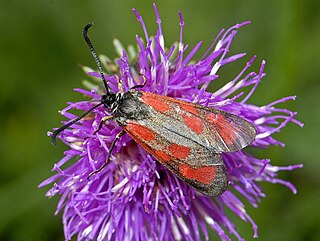
The Zygaenidae moths are a family of Lepidoptera. The majority of zygaenids are tropical, but they are nevertheless quite well represented in temperate regions. Some of the 1000 or so species are commonly known as burnet or forester moths, often qualified by the number of spots, although other families also have 'foresters'. They are also sometimes called smoky moths.

Zygaena loti, the slender Scotch burnet, is a moth of the family Zygaenidae. It is a diurnal moth characterized by a black body, light colored legs, and red spots on its wings. The caterpillars are a yellow-green color and usually molt out of dormancy in late February to early March. The larvae feed on plants from the family Fabaceae until they enter their pupal stage and mature into adults in May to early June. For mating, Zygaenidae exhibit a dual-partner finding strategy, where females use pheromones while assuming a calling position, and males exhibit a patrolling behavior where they utilize both vision and the olfactory receptors in their antennae to locate a potential mate. Although regionally endangered as their population is declining, Z. loti is found all across Europe, inhabiting areas rich in their desired food plants: lime-rich, and characterized by a hot and dry climate. The decreases in their population are likely due to factors such as habitat loss and fragmentation brought on by commercial agriculture and urbanization, as well as global climate change. There are few conservation programs currently focusing on Zygaena loti.
Hestiochora xanthocoma is a moth of the family Zygaenidae. It is found Australia from the tropical parts of the Northern Territory and Queensland.

Pollanisus viridipulverulenta, the satin-green forester, is a moth of the family Zygaenidae. It is found in the eastern part of Australia.
Pollanisus nielseni is a moth of the family Zygaenidae. It inhabits the Australian state of Western Australia, mostly coastal areas, and has brilliantly shiny forewings. The diurnal adults are most active on sunny days. Eggs are laid on the plant Hibbertia spicata, and females touch each egg after oviposition with a tuft of hair on their abdomen, which attaches protective spines. The larvae are brightly coloured and feed on H. spicata before pupation.
Pollanisus empyrea is a moth of the family Zygaenidae. It is endemic to the temperate parts of the Australian state of Western Australia.

Pollanisus is a genus of moths of the family Zygaenidae. They are native to Australia and many species have metallic forewings and bodies.
Homophylotis thyridota is a species of moth in the family Zygaenidae. It is found in Australia from north-eastern Queensland.
Homophylotis pseudothyridota is a species of moth in the family Zygaenidae. It is found in Australia from north-eastern Queensland.
Homophylotis artonoides is a species of moth in the family Zygaenidae. It is found in Australia from Queensland.
Myrtartona coronias is a species of moth in the family Zygaenidae. It is found in eastern and south-eastern Australia, from southern Queensland to Tasmania.
Myrtartona leucopleura is a species of moth in the family Zygaenidae. It is found in Queensland, New South Wales and the Australian Capital Territory.

Myrtartona rufiventris is a species of moth in the family Zygaenidae. It is found in Western Australia, South Australia and Victoria.
Onceropyga anelia is a species of moth in the family Zygaenidae. It is found in Australia in eastern Queensland and the northern parts of eastern New South Wales.
Onceropyga pulchra is a species of moth in the family Zygaenidae. It is found in Australia in south-eastern Queensland and eastern New South Wales.
Palmartona is a genus of moths in the family Zygaenidae. It contains only one species, Palmartona catoxantha, which is found from Myanmar eastwards throughout Malaysia, Singapore, Indonesia, the Philippines (Palawan) to Papua New Guinea. There is one record for Australia (Queensland).
Pseudoamuria neglecta is a species of moth in the family Zygaenidae. It is found in Queensland, Australia.
Thyrassia inconcinna is a species of moth in the family Zygaenidae first described by Charles Swinhoe in 1892. It is found in Queensland, Australia.
Thyrassia procumbens is a species of moth in the family Zygaenidae. It is found on Java and Sumatra.




